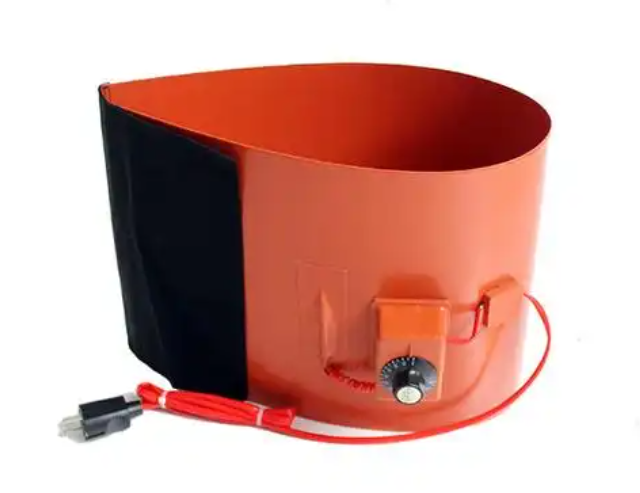A flexible strip heater is a thin, bendable heating element designed to deliver consistent and controllable heat across a surface. It’s widely used in industrial, laboratory, and commercial applications where space is limited, but reliable heat is essential.
These heaters are built using durable materials such as silicone rubber, polyimide (PI), or mica, depending on the temperature range and environmental requirements. They are known for their fast heat response, lightweight structure, and uniform thermal output, making them ideal for surface heating, freeze protection, and process control.
The working principle is simple yet efficient. Inside each heater lies a resistive wire or etched foil circuit. When electrical current passes through it, resistance generates heat, which is then transferred to the surface or medium it’s attached to.
The heat output is usually measured in W/cm², and the power density can be customized based on the application — from gentle warming to high-intensity heating.
Flexible strip heaters can operate from low voltage (12V, 24V) systems up to 240V AC mains, depending on the power requirement and safety conditions.

The choice of material defines performance, temperature limits, and durability. The most common types include:
Each material provides unique benefits. For most flexible applications, silicone heaters are preferred due to their strength, insulation, and wide temperature tolerance.
A flexible strip heater with thermostat includes an integrated or external temperature control unit. The thermostat regulates the heater’s operation by turning the power on or off once the preset temperature is reached.
This control mechanism prevents overheating and extends the lifespan of the heater. It also improves energy efficiency and safety, which are critical in applications like:
Thermostats can be either mechanical (bi-metal switch) or digital (sensor-based PID controller). The selection depends on accuracy and cost requirements.

When selecting a flexible strip heater, engineers should consider:
1. Temperature range: Maximum and continuous working temperatures.
2. Power density: Desired wattage per square centimeter.
3. Voltage rating: Compatibility with system voltage.
4. Surface type: Smooth or curved surfaces may affect heat transfer.
5. Environmental factors: Exposure to moisture, chemicals, or vibration.
6. Control method: Whether you need an external thermostat, sensor, or PID control system.
If the heater will operate unattended or near sensitive components, a flexible strip heater with thermostat is strongly recommended.
Temperature control ensures both safety and precision. Without proper regulation, excessive heat may degrade adhesives, shorten heater lifespan, or damage surrounding components.
For industrial systems, thermostats maintain process consistency. In medical or analytical devices, they preserve delicate conditions critical for performance.
For instance, when a PI flexible strip heater is used in semiconductor equipment, even a small temperature deviation can affect product quality. Hence, reliable control is a must.
Installation depends on the surface and usage environment:
During installation, ensure:
Incorrect mounting can lead to hot spots or premature failure.
Flexible strip heaters are incredibly versatile. Some of the most common applications include:
Each application benefits from the heater’s thin profile and quick response.

Proper maintenance extends lifespan and reliability. Here are a few key tips:
These simple steps reduce downtime and improve system efficiency.
Testing verifies both safety and thermal consistency. Standard checks include:
For quality assurance, trusted manufacturers test every unit before shipment.
A built-in or external thermostat offers multiple advantages:
This combination is perfect for applications where continuous heat control is essential, such as battery heaters, enclosure warmers, and analytical devices.
Absolutely. At Danyu Electronics, flexible strip heaters can be tailor-made to fit your equipment and working conditions. Customization options include:
If you have any other requirements, you are welcome to tell us and our team will try their best to serve you.
Danyu Electronics is a professional manufacturer of custom heating solutions, including PI and silicone flexible strip heaters. Our engineering team designs each heater with precision and reliability in mind.
Key advantages of choosing Danyu Electronics include:
Whether you need a flexible strip heater with thermostat for electronics, medical, or industrial equipment, Danyu Electronics provides dependable and efficient thermal solutions tailored to your needs.
1. What temperature range can a flexible strip heater handle?
Flexible strip heaters typically operate between -60°C to 200°C, depending on the material. Silicone rubber heaters are stable up to 200°C, while polyimide (PI) versions are better suited for lower-temperature, precision applications up to about 150°C. For extreme conditions, special high-temperature materials may be customized.
2. Can I cut or trim a flexible strip heater to fit my surface?
No. Cutting or trimming the heater can damage the internal resistance circuit, leading to failure or short circuits. Instead, request custom sizes and shapes from your manufacturer to ensure a perfect fit without compromising safety or performance.
3. How accurate is the thermostat in a flexible strip heater with thermostat?
A built-in mechanical thermostat usually maintains temperatures within ±5°C, while a digital thermostat or PID controller can control within ±1°C. The level of accuracy depends on your application — for sensitive systems, digital control is strongly recommended.
4. What’s the best way to mount a flexible strip heater?
Flexible strip heaters can be installed using 3M adhesive backing, clamps, or vulcanized bonding. For temporary or removable setups, adhesive or clamp mounting works well. For long-term use or high temperatures, vulcanization gives the best thermal contact and durability.
5. How long does a flexible strip heater last?
With proper installation and temperature control, a high-quality flexible strip heater can last over 10,000 hours of continuous use. Avoid overvoltage, overheating, or poor surface contact, as these are the most common causes of premature failure.
Simply drop your email or phone number in the contact form, and we'll promptly reply you shortly.